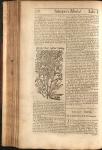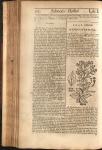
 This chapter hasn't been proofread yet.
This chapter hasn't been proofread yet.
I. The Names. It is called in Greek, "Aa*tw : la A Latin, Alfine : In Engiifh, Chickweed. II. The Kinds. There are three pr.ncipal kinds, i- "Αλί™» κοινή-, Alfine Communis, Common Chick-weed. 2. *Aa™ W£«, Alfine aquatica, Water or Marih Chickweed, of which in the next Chapter. ^Wn >S9», Alfine notha, Baftard Chios-weed, of which we (hall treat in Chap, r 29. Of the Common kind, there is, 1. Alfine maxima, Lug-
dunenfis ·,
dunenfis ·, Anguftifolia Bauhini, Our Greateft Chick-weed : Gerard calls it, Alfine major. 2. Alfine minor, Our Common small Chickweed: 3. Alfine Baccifera, and Baccifera repens, Cacubalum Plinij, Alfine repens Chfij, Berry-bearing Chick-weed, and Spreading Chickweed.
a Man, if it ftands by bufhes or other things, where it may take hold-, owerwife, through weakness, fhey lye upon the ground, andfo feem not fo long or tall. At every one of the Joints ft and two Leaves, one against another, much like to the Common Great Chickweed Leaves, but larger, and coming somewhat near to those of Pellitory of the Wall, and of afrefk green color. At the Joints also, on both sides of the Stalks come forth other Branches, jointed and set with the like fafhioned Leaves in the fame manner, and at the ends of them large, green, round Husks, ending in five points, with white Plowers growing but of them, confifting of five, and sometimes of Jix white Leaves apiece, cut in at the ends : in which Husks, after the Plowers are past, (land small round Heads, like Berries, green at the firfi, and blackifh when they are ripe, containing within them many fiat, blackifh, purple Seed. This Plant has only an herby tafie, like to the Common Chick-weeds, and therefore the Learned Botanifts refer it to them.
III The Descriptions. The firft has a white thready Root, small and confifting of several little firings like hairs from whence rife up Stalks a foot or foot and half high, and sometimes higher, a great many from one Root, longs and round, flender, full of Joints, with two Leaves growing out of every Knot or Joint, almoft as large, and as long or longer than Pellitory Leaves, to which they are very like infhape or form, but fmooth, without any hairynefs or downi-nefs, and of a light green color. The Stalks are somewhat clear, and as it were perlucid, or tranfparent ·, and about the Joints they are often of a very light red color. The rlmoers are at the tops of the Branches, being white, and confifting of fix Leaves apiece, standing in long green Husks, not much unlike to the Plowers of Stitchwort, but lesser. Which being past, in their places fucceed long Knops, or. Seed Veftels, but not great, containing within them small yellowifh Seed.
IV. The second has a Root white, and full also of little firings, from whence spring many Stalks or Branches, as in the former^ which for the moft part lye upon the ground : The Stalks are small, round, long,flender, brittle, or very tender, and jointed: from which fielder Branches spring Leaves, refem-bling the precedent, but much less, as is likewife the whole Plant, which in no refpetf attains to the great-nefs of the former, the plowers are also in like manner white and small, standing in like fafhioned green long husks ·, which being past, the said Husks or Knops contain small yellowifh Seed.
V. The third has a Root which is white and long, creeping much under ground, and fhooting forth in divers places every year new Jhoots, the old dying away every Tear -.from this Root come forth many flexible Branches full of Joints, rifing higher than
VI. The Places. The first grows almoft every where throughout England, by Highways and Ditch sides, in moist and watry places, especialiy if the Earth is rich. The second is found also in many of the like places, as also in Gardens, where many times it vS a moft pernicious Weed. The laft, Clu-fu/s fays, grows in several places of Spain and Germany ·, as also in Plunders and England^ as Pend and Lobel say Parkinson fays, that he had sometimes found it by Hedge sides in our own Land.
VII. The Times. Chickweed is moltly green iri Winter % they Flower in Spring and Summer 4, arid their Seed is ripe in June and fitly.
VIII. The Qualities. They are cold and moist in the second Degree : Emollient, Arthritick, An^dyn, and Alterative : Galen and Oribafius fay, they are without any Aftringent Quality.
IX. The Specification. Their Juice is peculiar a-gainft the Mammation called St. Anthomes hre.
A a 2 λ» hot
X. i 6* Preparation*. You may have therefrom, i. A Juke. 2. 3. Λ Diftilled Wa-
ter. 4. ΛλΟ//. 5. ii Cataplafm: 6. A Compound
Oil.
The Virtues.
XI. The Juice. It is very Cooling and Emollient, without any binding property. Galen and others fay, that it has the Virtues of Pellitory oj the Wall; but that I doubt^ however it is commonly found to be as eriecFual as Purftain to all the putpoies whereunto that ferves, except for Meat or Salleting only. Applied with Cloths or Spunges dipped therein, to the Region of the Liver, and as they dry, to have freih applied, does wonderfully attemperate the heat of the Liver. The fame also is effectual for all hot Apoftems and Tumors wherefoever, and is profitable against Ignis facer, or Anthonics Fire, and the like ·, as also for all rednefs of the Face, Wheals, Pufhes, Itch, Scabs, either limply ufed, or made into an Ointment with Lard. It is good for all heat and rednefs of the Eyes, being dropt into them ; also put into the Ears warm, it eafes their pain proceed/iig from a hot cause. The Piles bathed, or fomented therewith, it abates their pain, and takes away their heat and sharpnefs, and eafes all other pains of the Body proceeding from heat and sharpness of Humors. It is good against hot and virulent Sores and Ulcers in the Privy Ruts, Legs, or ellewhere, they being often waihed therewith.
XII. The Eftence. It cools Inflammations of the Lungs, without any binding property, and takes away the heat of the Stomach and Liver, breaking out into the Lips, causes Appetite, being loft thro5 too much heat, is prevalent against HecFick Fevers, as also the heat and pain in the Back, and the sharpness and fcalding of Urine. Dole from one to two or three ounces Morning and Jtfight.
XIII. The Distilled Water. It has the Virtues of the Juice, but much less effecFual; and may be used as a Vehicle to take the Effence in.
XIV. the Oil. Made by boiling the Herb in Oil Olive, till it is crifp, and repeating it three or four times with tfefh Flerbs, it heals fore Legs, Ulcers, Wheals, Pufhes, Scabs, and the like : and being an ointed upon ihrunk up Sinews, it extends them, eafes their pains, and makes them pliable again.
. XV. rThe Cataplasm. Ifc of Chickweed jour hand fuls: Marft-wallows, two handjuls; mix and boil them to a Pultife, with fenugreek Seed, Pinfeed, ana, two ounces, bruijed. This applied to Tumors, or Apoftems, ripens and breaks them, affvvages the Swelling, and eales the Pain.
XVI. The Compound Oil. Take green Cluckweed, frejh Red R>jc Lcuves, oj each two handfuls : Oil of Trotters, two pounds : boil till they are crifp, and flrain out : repeat this boiling with frejh Chickweed, and Red Rofe Leaves, twice more: flrain out, and keep it for use. Being anointed warm, and well rubbed in upon Sinews which are strained, it is a moft excellent thing : Let it be used Morning and Evening, and in a little time the Patient will be cured.
XVII. TJ}e Virtues of the Alfine Baccifera. Some Authors fay, that it is no less fatal to be eaten than thefteepy Mghtfiade: but others fay, of the Cacu-bulum Ριιηη otherwife : and that If the Leaves thereof be beaten with fome Vinegar, and applied to the place ftung with Scorpions or Serpents, it helps them : And that the Juice thereof taken, wkh twice as much honied Wine, it eafes the pains of the Back and Loins ·, also the Head-ach ( from a hot cause ) if it is applied with Rofe Watex to the
Forehead and Temples : and that being bound to Wens or Kernels, or they bathed often with its Juice, it difTolves them.
Botanologia, or The English Herbal, was written by William Salmon, M.D., in 1710.

 Page 214
Page 214 Page 215
Page 215 Page 216
Page 216